高中英语语法_倒装句
- 格式:rtf
- 大小:66.39 KB
- 文档页数:2
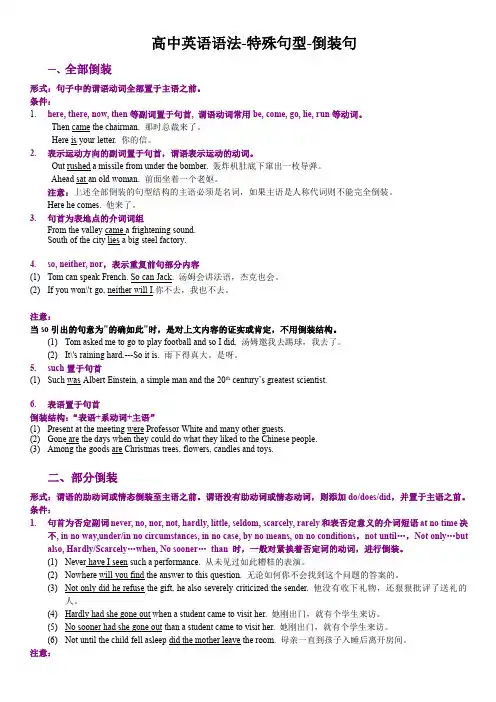
高中英语语法-特殊句型-倒装句一、全部倒装形式:句子中的谓语动词全部置于主语之前。
条件:1.here,there,now,then等副词置于句首,谓语动词常用be,come,go,lie,run等动词。
Then came the chairman.那时总裁来了。
Here is your letter.你的信。
2.表示运动方向的副词置于句首,谓语表示运动的动词。
Out rushed a missile from under the bomber.轰炸机肚底下窜出一枚导弹。
Ahead sat an old woman.前面坐着一个老妪。
注意:上述全部倒装的句型结构的主语必须是名词,如果主语是人称代词则不能完全倒装。
Here he comes.他来了。
3.句首为表地点的介词词组From the valley came a frightening sound.South of the city lies a big steel factory.4.so,neither,nor,表示重复前句部分内容(1)Tom can speak French.So can Jack.汤姆会讲法语,杰克也会。
(2)If you won\'t go,neither will I.你不去,我也不去。
注意:当so引出的句意为"的确如此"时,是对上文内容的证实或肯定,不用倒装结构。
(1)Tom asked me to go to play football and so I did.汤姆邀我去踢球,我去了。
(2)It\'s raining hard.---So it is.雨下得真大。
是呀。
5.such置于句首(1)Such was Albert Einstein,a simple man and the20th century’s greatest scientist.6.表语置于句首倒装结构:“表语+系动词+主语”(1)Present at the meeting were Professor White and many other guests.(2)Gone are the days when they could do what they liked to the Chinese people.(3)Among the goods are Christmas trees,flowers,candles and toys.二、部分倒装形式:谓语的助动词或情态倒装至主语之前。

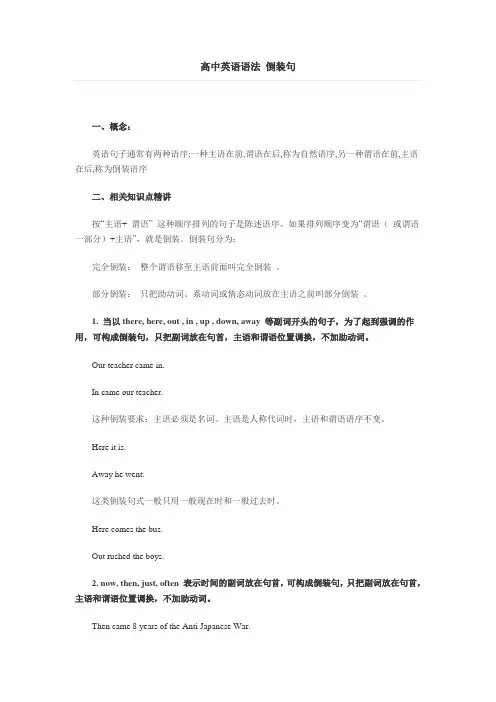
高中英语语法倒装句一、概念:英语句子通常有两种语序:一种主语在前,谓语在后,称为自然语序,另一种谓语在前,主语在后,称为倒装语序二、相关知识点精讲按“主语+ 谓语” 这种顺序排列的句子是陈述语序。
如果排列顺序变为“谓语(或谓语一部分)+主语”,就是倒装。
倒装句分为:完全倒装:整个谓语移至主语前面叫完全倒装。
部分倒装:只把助动词、系动词或情态动词放在主语之前叫部分倒装。
1. 当以there, here, out , in , up , down, away 等副词开头的句子,为了起到强调的作用,可构成倒装句,只把副词放在句首,主语和谓语位置调换,不加助动词。
Our teacher came in.In came our teacher.这种倒装要求:主语必须是名词。
主语是人称代词时,主语和谓语语序不变。
Here it is.Away he went.这类倒装句式一般只用一般现在时和一般过去时。
Here comes the bus.Out rushed the boys.2. now, then, just, often 表示时间的副词放在句首,可构成倒装句,只把副词放在句首,主语和谓语位置调换,不加助动词。
Then came 8 years of the Anti Japanese War.3. 表地点状语的介词短语放在句首,要用倒装句式,以示强调。
这种倒装句也是主谓直接调换位置,不加助动词did, does或do.Under a big tree ________, half asleep.A. did sat a fat manB. a fat man satC. did a fat man satD. sat a fat man4. there放在句首时,要用倒装句式。
在“there + be”结构中的谓语动词有时不用be , 而用表示类似“存在”观念的其他不及物动词。
如:live, stand, come, lie, flow, enter, rise 和appear等。
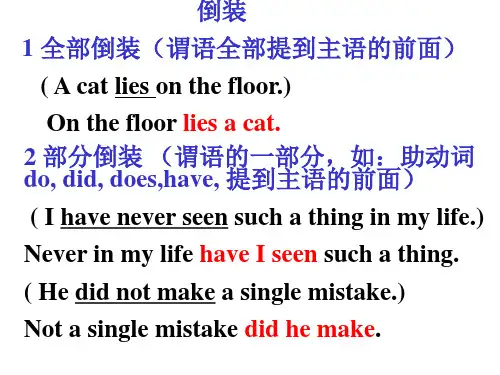
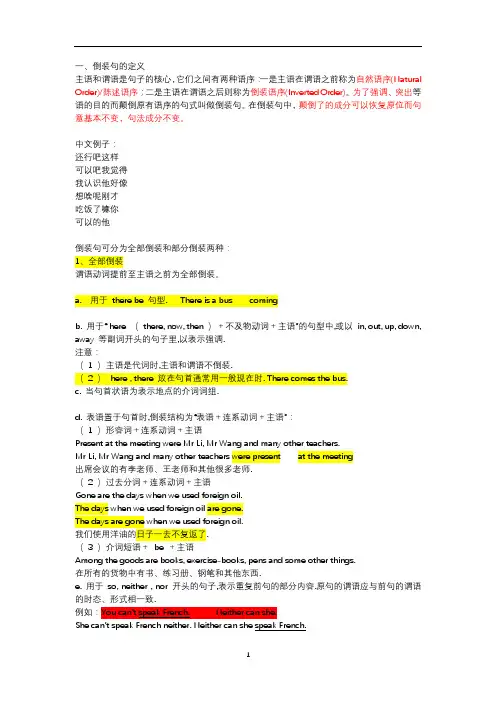
一、倒装句的定义主语和谓语是句子的核心,它们之间有两种语序:一是主语在谓语之前称为自然语序(Natural Order)/陈述语序;二是主语在谓语之后则称为倒装语序(Inverted Order)。
为了强调、突出等语的目的而颠倒原有语序的句式叫做倒装句。
在倒装句中,颠倒了的成分可以恢复原位而句意基本不变,句法成分不变。
中文例子:还行吧这样可以吧我觉得我认识他好像想啥呢刚才吃饭了嘛你可以的他倒装句可分为全部倒装和部分倒装两种:1、全部倒装谓语动词提前至主语之前为全部倒装。
a.用于there be 句型. There is a bus comingb. 用于“ here (there, now, then )+不及物动词+主语”的句型中,或以in, out, up, down, away 等副词开头的句子里,以表示强调.注意:(1 )主语是代词时,主语和谓语不倒装.(2 )here , there 放在句首通常用一般现在时. There comes the bus.c. 当句首状语为表示地点的介词词组.d. 表语置于句首时,倒装结构为“表语+连系动词+主语”:(1 )形容词+连系动词+主语Present at the meeting were Mr Li, Mr Wang and many other teachers.Mr Li, Mr Wang and many other teachers were present at the meeting出席会议的有李老师、王老师和其他很多老师.(2 )过去分词+连系动词+主语Gone are the days when we used foreign oil.The days when we used foreign oil are gone.The days are gone when we used foreign oil.我们使用洋油的日子一去不复返了.(3 )介词短语+be +主语Among the goods are books, exercise-books, pens and some other things.在所有的货物中有书、练习册、钢笔和其他东西.e. 用于so, neither , nor 开头的句子,表示重复前句的部分内容.原句的谓语应与前句的谓语的时态、形式相一致.S he can’t speak French neither. Neither can she speak French.You are a good student. 他也是。
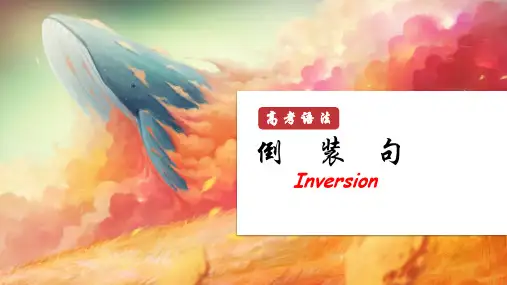
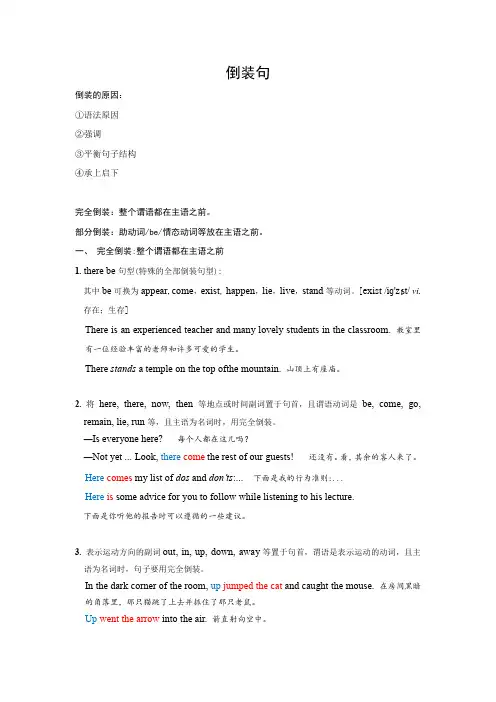
倒装句倒装的原因:①语法原因②强调③平衡句子结构④承上启下完全倒装:整个谓语都在主语之前。
部分倒装:助动词/be/情态动词等放在主语之前。
一、完全倒装:整个谓语都在主语之前1. there be句型(特殊的全部倒装句型):其中be可换为appear, come,exist, happen,lie,live,stand等动词。
[exist/iɡ'zɪst/ vi.存在;生存]There is an experienced teacher and many lovely students in the classroom. 教室里有一位经验丰富的老师和许多可爱的学生。
There stands a temple on the top ofthe mountain. 山顶上有座庙。
2. 将here, there, now, then等地点或时间副词置于句首,且谓语动词是be, come, go, remain, lie, run等,且主语为名词时,用完全倒装。
—Is everyone here? 每个人都在这儿吗?—Not yet ... Look, there come the rest of our guests! 还没有。
看,其余的客人来了。
Here comes my list of dos and don’ts:... 下面是我的行为准则:...Here is some advice for you to follow while listening to his lecture.下面是你听他的报告时可以遵循的一些建议。
3. 表示运动方向的副词out, in, up, down, away等置于句首,谓语是表示运动的动词,且主语为名词时,句子要用完全倒装。
In the dark corner of the room, up jumped the cat and caught the mouse. 在房间黑暗的角落里,那只猫跳了上去并抓住了那只老鼠。
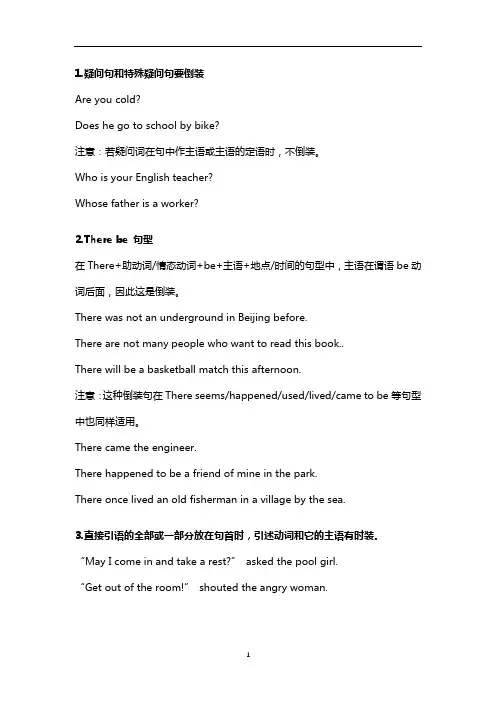
1.疑问句和特殊疑问句要倒装Are you cold?Does he go to school by bike?注意:若疑问词在句中作主语或主语的定语时,不倒装。
Who is your English teacher?Whose father is a worker?2.There be 句型在There+助动词/情态动词+be+主语+地点/时间的句型中,主语在谓语be动词后面,因此这是倒装。
There was not an underground in Beijing before.There are not many people who want to read this book..There will be a basketball match this afternoon.注意:这种倒装句在There seems/happened/used/lived/came to be等句型中也同样适用。
There came the engineer.There happened to be a friend of mine in the park.There once lived an old fisherman in a village by the sea.3.直接引语的全部或一部分放在句首时,引述动词和它的主语有时装。
“May I come in and take a rest?”asked the pool girl.“Get out of the room!”shouted the angry woman.4.以here, there, now, in ,out, up, down, away, then等副词开头的句子中,句子要倒装,以示强调。
习惯上,除以then开头的句子用过去时外,其余一般使用现在时。
There goes the bell.铃声响了。
There comes the bus! 汽车来了。
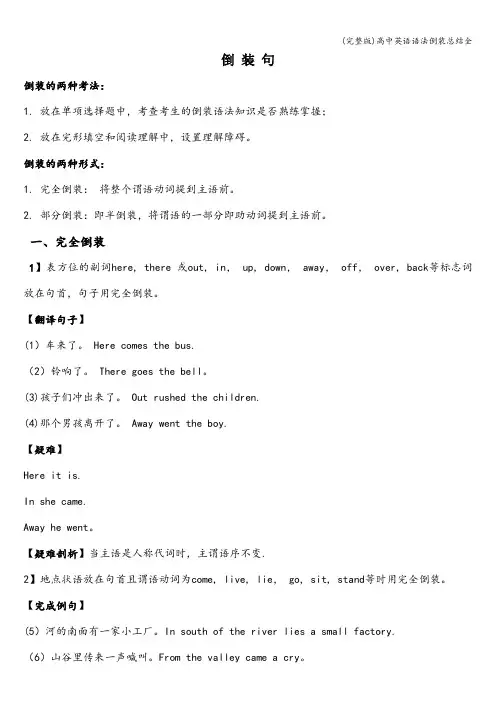
倒装句倒装的两种考法:1. 放在单项选择题中,考查考生的倒装语法知识是否熟练掌握;2. 放在完形填空和阅读理解中,设置理解障碍。
倒装的两种形式:1. 完全倒装:将整个谓语动词提到主语前。
2. 部分倒装:即半倒装,将谓语的一部分即助动词提到主语前。
一、完全倒装1】表方位的副词here, there 或out, in, up, down, away, off, over, back等标志词放在句首,句子用完全倒装。
【翻译句子】(1)车来了。
Here comes the bus.(2)铃响了。
There goes the bell。
(3)孩子们冲出来了。
Out rushed the children.(4)那个男孩离开了。
Away went the boy.【疑难】Here it is.In she came.Away he went。
【疑难剖析】当主语是人称代词时,主谓语序不变.2】地点状语放在句首且谓语动词为come, live, lie, go, sit, stand等时用完全倒装。
【完成例句】(5)河的南面有一家小工厂。
In south of the river lies a small factory.(6)山谷里传来一声喊叫。
From the valley came a cry。
3】 such, the following等放句首时,句子要完全倒装。
【翻译句子】(7)Such are the facts. 情况就是如此。
(8)生活就是这样。
Such is life.(9)The following is the answer to the question。
这个问题的答案如下。
4】There lie / exist / stand / live +主语+…是there be 句型的变式【翻译句子】(10)山顶上有一幢高楼.There is a tall building on the top of the mountain.(11)山顶上耸立着一座古塔。
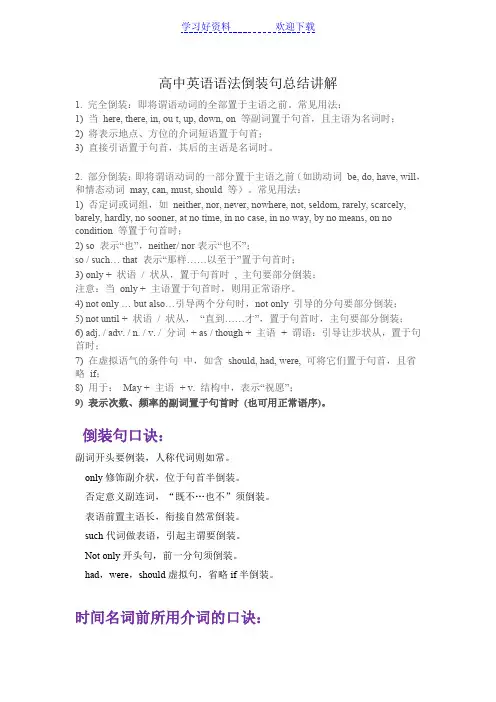
高中英语语法倒装句总结讲解1. 完全倒装:即将谓语动词的全部置于主语之前。
常见用法:1) 当here, there, in, ou t, up, down, on 等副词置于句首,且主语为名词时;2) 将表示地点、方位的介词短语置于句首;3) 直接引语置于句首,其后的主语是名词时。
2. 部分倒装:即将谓语动词的一部分置于主语之前(如助动词be, do, have, will,和情态动词may, can, must, should 等)。
常见用法:1) 否定词或词组,如neither, nor, never, nowhere, not, seldom, rarely, scarcely, barely, hardly, no sooner, at no time, in no case, in no way, by no means, on no condition 等置于句首时;2) so 表示“也”,neither/ nor表示“也不”;so / such… that 表示“那样……以至于”置于句首时;3) only + 状语/ 状从,置于句首时, 主句要部分倒装;注意:当only + 主语置于句首时,则用正常语序。
4) not only … but also…引导两个分句时,not only 引导的分句要部分倒装;5) not until + 状语/ 状从,“直到……才”,置于句首时,主句要部分倒装;6) adj. / adv. / n. / v. / 分词+ as / though + 主语+ 谓语:引导让步状从,置于句首时;7) 在虚拟语气的条件句中,如含should, had, were, 可将它们置于句首,且省略if;8) 用于:May + 主语+ v. 结构中,表示“祝愿”;9) 表示次数、频率的副词置于句首时(也可用正常语序)。
倒装句口诀:副词开头要例装,人称代词则如常。
only修饰副介状,位于句首半倒装。
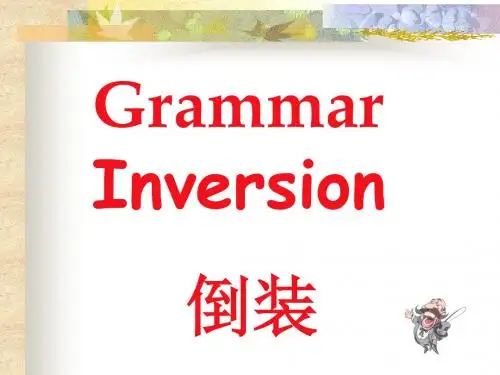
高中英语语法倒装句谓语或谓语的一部分放在主语之前的语法现象,就称之为倒装。
从倒装的形式来看,可分为完全倒装和部分倒装两大类。
前者是指整个谓语置于主语之前,而而后者仅指助动词、情态动词或be动词等置于主语之前。
一. 完全倒装完全倒装又可称为全部倒装。
完全倒装是只将句子中的谓语动词全部置于主语之前。
此结构通常只用于一般现在时和一般过去时。
常见的结构有:(1)here,there,now,then,thus等副词置于句首,谓语动词常用be,come,go,lie,run等表示来去或状态的动词。
例如:Then came the teacher. 那时老师来了。
Here is your letter. 你的信。
(2)表示运动方向的副词或地点状语置于句首,谓语表示运动的动词。
例如:Ahead sat an old woman. 前面坐着一个老大妈。
注意:上述全部倒装句型结构的主语必须是名词,如果主语是人称代词则不能完全倒装。
例如:Here he comes. 他来了。
Away they went. 他们走开了。
二. 部分倒装部分倒装是指将谓语的一部分如助动词或情态倒装放到主语之前。
如果句子的谓语没有助动词或情态动词,则需添加助动词do,does 或did,并将其置于主语之前。
(1)句首为否定或半否定的词语,如no, not, never, seldom, little, hardly, at no time, in no way, not until…等。
例如:Never have I seen such a performance.从未见过如此糟糕的表演。
Nowhere will you find the answer to this question.无论如何你不会找到这个问题的答案的。
Not until the child fell asleep did the mother leave the room.母亲一直到孩子入睡后才离开房间。
倒装句一、全部倒装全部倒装即把整个谓语部分放在主语之前。
当副词here, there, in, out, up, down, away, back, then, ahead, off, over等位于句首、谓语动词常为be, come, go, follow, run, rush, fly, fall等不及物动词,而且主语又是名词时,用完全倒装。
注意:此类倒装只限于一般现在时和一般过去式,不用进行时态并且若主语是代词时,不用倒装。
同学们可借助下面的图形速记用于完全倒装的词。
1.介词短语(地点状语)+不及物动词+主语Under the tree sits a beautiful girl.=A beautiful girl sits under the tree. 树下坐着一位漂亮的女孩。
South of the lake lies a big supermarket. 湖泊的南边是一个大超市。
20 miles east of our school lies a modern swimming pool. 我们学校向东20英里有一个现代化的游泳池。
On the floor were piles of old books, magazines and newspapers. 地板上是一堆堆旧的书报杂志。
2.表方向、地点的副词(here, there, up, down, away)+不及物动词+主语,构成的全部倒装句Hearing the dog barking fiercely, away fled the thief. 听到狗的狂叫声,小偷逃掉了。
Here comes the bus. 公交来了。
There goes the bell. 铃响了。
3.“主+系+表”结构如强调表语通常转化为“表+系+主”(表语通常为形容词、现在分词和过去分词)的全部倒装句。
Happy are those who are contented. =Those who are contented are happy. 知足常乐。
倒装句英语句子的主语通常位于谓语动词之前,这种语序被称为正常语序。
但有时出于强调或某种特殊的语法结构的需要,需要将谓语动词放在主语之前,这种语序则叫倒装语序。
按倒装的形式,倒装可分为两类,一是完全倒装,二是部分倒装。
完全倒装是指全部谓语放在主语之前,部分倒装是指只把助动词、情态动词或be动词放在主语之前,谓语的主体部分仍在主语之后。
一、完全倒装1. 用于there be 句型。
例:There are many students in the classroom.原句自然顺序是:Many students are there in the classroom.★2. 表示地点的here 和there 位于句首时,其后用完全倒装形式。
这类倒装句的谓语通常是动词be 和come, go 等表示移动或动态的不及物动词,以及stand, lie, live 等表示状态的动词(表示存在)。
例:Here comes the bus. 公共汽车来了。
There goes the last train. 最后一班火车开走了。
There stood a desk against the wall. 靠墙放着一张书桌。
注意:若主语为人称代词,则不倒装。
如:Here you are. 这就是你要的东西。
(给你。
)Here it comes. 它来了。
★3. 表示方向的副词away, down, in, off, out, over, round, up 等位于句首时,其后用完全倒装语序。
这类倒装句的谓语通常表示动态的不及物动词。
Out rushed the puppy. 小狗冲了出去。
Away went the girl. 那个女孩走远了。
Down came the rain and up went the umbrellas. 下雨了,伞都撑起来了。
注:若主语为人称代词,则不能用倒装。
如:In he comes. 他走了进来。
英语倒装句分为两种:
1、整个谓语在主语前的句子,叫完全倒装。
In came our English teacher.
There is a table in the room.
2、部分谓语(情态动词、主动词、连系动词)在前,谓语的主体部分仍在主语之后的句子,叫不完全倒装句/部分倒装。
Why did you do it like that?
Seldom have I been to Beijing.
一、完全倒装
1. There be 句型
there be 句子中,谓语是be, exist, live, lie 等表示状态的不及物动词。
动词后的名词为句子的主语。
句子的谓语应与最靠近它的主语相一致
There is nobody in the classroom.
There seems something wrong with my radio.
There happened an event last week.
There stands a temple on the top of the mountain.
2. 用于方位副词(here、there、now、out、in、then、up、down、away、over、off、back 等)开头的句子中。
Look, here comes the bus!
Out went the children.
The door opened and in came Mr. Smith, our headmaster.
Tips:
①当代词做句子的主语时,句子不能倒装。
②进行时不用于倒装!
Away they went. Back they fought.
Here he comes. Up it flew.
3. 方位介词短语位于句首时
On the top of the hill lies an old temple.
4. “分词+be+主语”
Walking at the head of the line was our teacher
Gone are the days when the Chinese people used foreign oil
Hanging on the wall was a clock made in Germany.
5. Such +be +主语
Such is what he said.
Such are his words
二、不完全倒装/部分倒装
1. 句首状语为否定词或半否定词的句子。
never, neither, nor, little, seldom, rarely, hardly, scarcely, no sooner, not only, in no way, at no time, few, not, no等
Never have I found him so happy.
Little does he care about his clothing
2. only + 状语放在句首,要部分倒装。
Only by this means is it possible to explain it.
Only then did I realize the importance of math.
Only when the war was over did he go back home
3. “Not only + 分句,but also + 分句”句型中的前一分句需要部分倒装
Not only does John love Chinese, he is also good at speaking it.
Not only are the students planting trees, but also the teacher is.
4. Not until放在句首,从句不倒装,主句倒装。
Not until last week did they find the lost bike
5. So……that 从句不倒装,主句部分倒装。
So suddenly did he catch the disease that the whole family were at a great loss
6. No sooner……than; Hardly……when; Scarcely ……when
No sooner had he gone out than he fell down
7.as引导的让步状语从句。
①. Child as he is, he knows a lot
②. Hardworking as he was, he failed to pass the test again
③. Try as he might, he failed again
④. Hard as he works, he earns little.
8. so 表示“也一样”,neither,nor 表示“也不”,放在句首..
I saw the film, so did she.
He hasn’t been to Beijing, neither have I.
Tom doesn’t like fish, nor do I
9 虚拟语气里面的倒装
虚拟语气if 从句中出现were /should/ had可以将这几个词提前到从句之前,if 去掉。